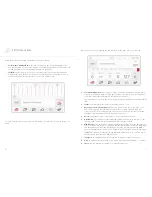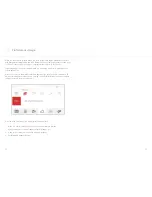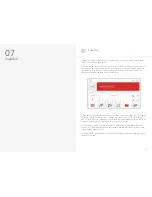
24
25
Filter
Modal 002R uses a classic analogue transistor ladder design to low-pass filter the signal
coming from the oscillators (or from an external source). Like every true polyphonic
synthesiser, Modal 002R has an individual VCF per voice.
1. Cutoff:
This parameter controls the low-pass filter cutoff frequency. The minimum value
(i.e. 0) corresponds to about 40 Hz.
2. Reso:
This parameter controls the amount of resonance of the filter. Note that with
the ladder filter design, resonance can go quite wild at high values; also, turning up
the resonance value dampens the low end of the sound a little bit. These are normal
consequences of this particular filter design.
3. Slope:
This parameter controls the shape of the filter: note that this is a real continuous
analogue filter morphing (quite a unique feature in the analogue domain), which gives to
the Modal 002 filter a unique characteristic.
•
At a value of 0 you have a 4-pole low pass filter;
•
At a value of 10-20, you have a sort of low-shelving;
•
In the midpoint (63) you have a band-pass filter;
•
At maximum value (127) a 1-pole low-pass filter.
TIP: With this feature you can dampen the low frequencies while maintaining a rich high-
end texture. For a good ‘light’ pad sound, try a value of 90 with a high Cutoff. Try values
other than 0, 63, and 127 for interesting, unique timbres.
4. EG:
This parameter controls the amount of envelope modulation (‘VCF-EG’ - see
‘Envelopes’ section in this same chapter) on the filter cutoff frequency. Note that this
parameter can also have negative sign. TIP: use a high negative EG value combined with
a long Release on the Envelopes, in order to get some nice ‘filter-opening’ effects when
releasing the keys.
5. LFO2:
This parameter directly controls the amount of LFO2 modulation (see
‘Modulations’ section - later in this same chapter) on the filter cutoff frequency. Note that
this parameter can also have negative sign.
6. Velocity:
This parameter controls the amount of keyboard velocity modulation on the
filter cutoff frequency: at positive values, the stronger you press the keys, the higher the
cutoff is set. Note that this parameter can also have negative sign.
7. Note:
This parameter controls the amount of keytracking modulation on the filter cutoff
frequency: at positive values, the higher the note you press, the higher the cutoff is set.
Note that this parameter can also have negative sign.
8. Offset:
This parameter controls the keytracking offset when using Note to CutOff
modulation. The offset is in semi-tones from the lowest note on the keyboard.








































